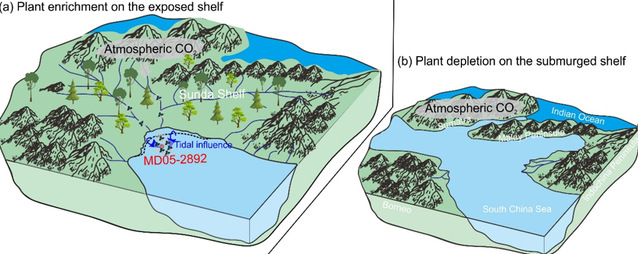Hongchao Zhao, Zhifei Liu * , Baozhi Lin, Yulong Zhao
State Key Laboratory of Marine Geology, Tongji University, Shanghai 200092, China
Abstract:Burial of terrigenous organic carbon in marine sediments serves as a net sink for atmospheric CO2 and therefore regulates global climate on geologic time scales. Woody debris is an important carrier of terrigenous organic carbon, but its burial in deep-sea sediments has been rarely reported. Here, woody debris from the last glacial sediments in the southern South China Sea was used for analyzing its abundance, organic carbon content, and organic carbon stable isotopes, in order to elucidate the burial of deep-sea woody debris and its contribution to carbon cycling. The woody debris presents the higher abundance (0.15 ± 0.14%) during the last glacial 14.3–20.8 cal ka BP while woody debris is lacking during the 2.0–14.3 cal ka BP, suggesting increased woody-debris burial during the last glaciation. The woody debris shows the constant organic carbon content (27.9%) and stable isotope value (−27.6‰) during the last glaciation, indicating its same C3 plant source. Combining woody-debris abundance, organic carbon content, and other published data, the last glacial burial of C3 plants in the southern South China Sea was estimated to have sequestered 0.39 ± 0.39 Gt carbon, contributing 3 ± 3‰ to the atmospheric CO2 reduction during the last glaciation. If similar magnitude can be identified in other low-latitude sea, the increased burial of C3 plants in deep-sea sediments could efficiently reduce the atmospheric CO2 during the last glaciation. This study proposes the glacial burial and interglacial absence of woody debris in the deep sea as a new carbon sequestration mechanism in the glacial carbon cycle.
Full Airticle: https://doi.org/10.1016/j.gloplacha.2024.104542

Fig. Schematic scenarios showing woody-debris burial in the deep sea and carbon cycle. (a) During the glacial sea-level lowstand, trees on the exposed shelf absorbed atmospheric CO2 and the woody debris was transported to the deep sea, resulting in high woody-debris burial in the deep sea and reduced atmospheric CO2 concentrations. (a) During the interglacial sea-level highstand, submerged vegetation resulted in low woody-debris burial and relatively high atmospheric CO2 concentrations.


